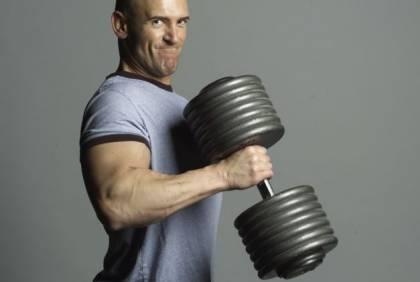Uncensored

Scott Welch has devoted his career studying performance enhancement and weight loss through dietary intervention. He received a bachelor of applied science degree in Nutrition from Ryerson University and later completed a post-graduate certificate in advertising. He’s had countless interactions with leading scientists, doctors, and hundreds of trainers from around the world, giving him a unique perspective that others lack. Welch founded MUSCLE INSIDER in 2009.

Fake Weights & Photoshoots
QUESTION: Is it true that fake weights are often used in photo shoots to make the champs seem stronger than they really are?
ANSWER: Yes, this is true! The fake weights are now made of aluminum, but they used to be made of Styrofoam. If you don’t believe me, check out the picture of me (Scott Welch) above doing hammer curls with 130-pound dumbbells! Those dumbbells are labeled as 130s, are metal, but weigh no more than 65 pounds each! Shocked? The pros are forced to lift heavier-than-normal weight for photos because this makes for a more impressive picture. To avoid injury, they often use fake weights when they’re shooting right before or after a show.
Here's what Chris Lockwood former Editor-In-Chief of Muscle & Fitness and Muscle & Fitness Hers had to say about the use of fake weights:
"While Editor-in-Chief at M&F and Hers, I was totally in favor of using fake weights when appropriate. When you're doing posed shots w/ models that are significantly depleted and being asked to shoot for 6-12 hours, it becomes a business decision to save on costs so that you don't have to use multiple models, shoot multiple days, injure a model, or jeopardize form when trying to educate a novice on proper lifting. When showing what's promoted as a real-life workout w/ a bodybuilding or strength celebrity though, I think its appropriate to use the real thing b/c that's what the article is promoting. When its just an exercise form article, fake or real weights don't bother me so long as the load depicted is realistic for the person performing the lift."
Trick #2 Lower The Weights Don't Lift Them
Another trick done in tons of bodybuilding and powerlifting photo shoots is to just take pictures of the bodybuilder holding and then lowering a crazy amount of weight! Then in the magazine, you just reverse the order of the photos so that the “start” is at the bottom of the lift and the “finish” is the photo taken before he or she lowered the weight to begin with. Reversing this order in the magazine layout makes it look like the athlete lifted the weight, but all they did was slow it down on the way to the floor!
Here is a video showing fake weights in action!
If you love this type of edgy news, subscribe to MUSCLE INSIDER magazine by clicking here!

